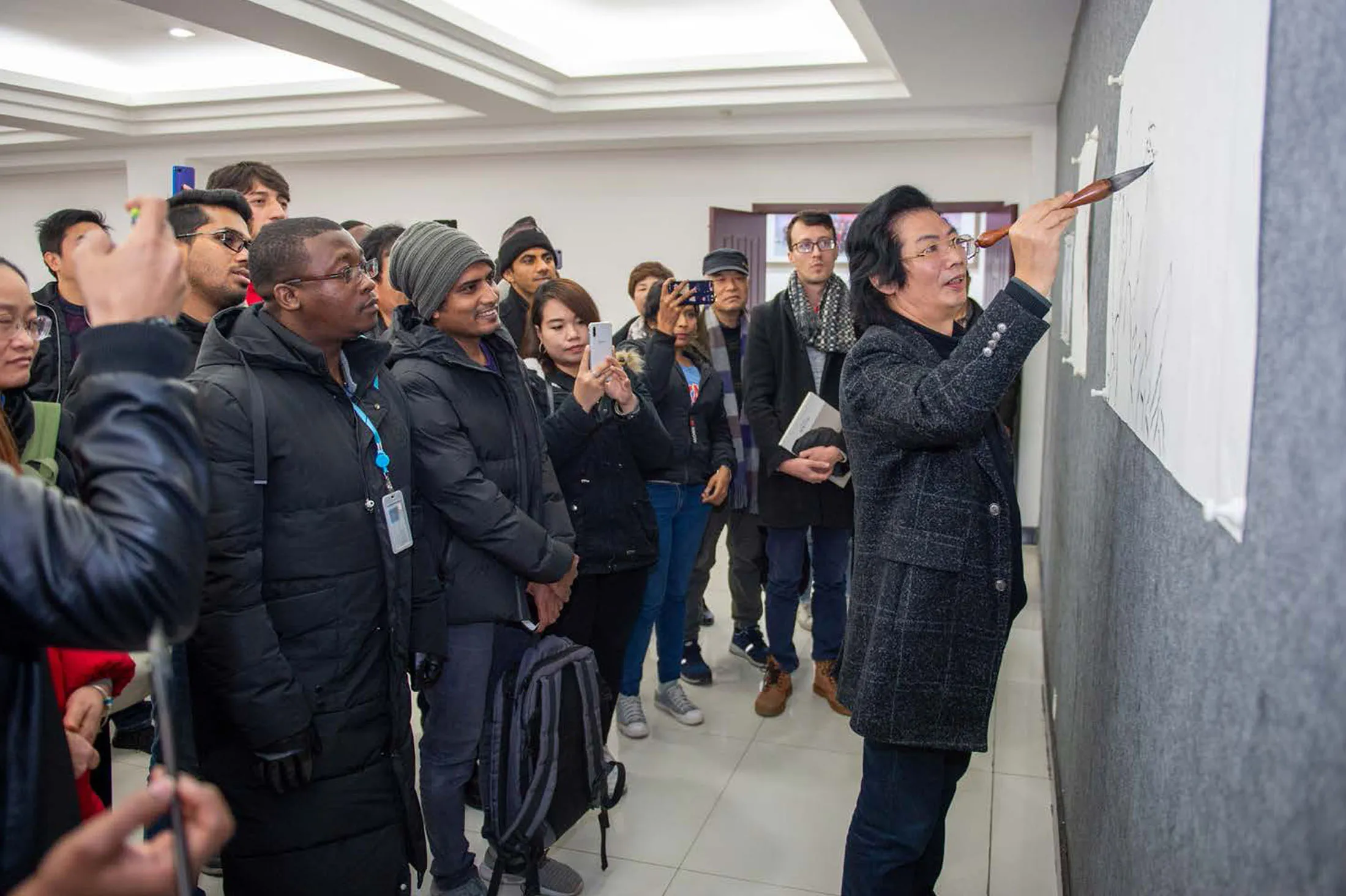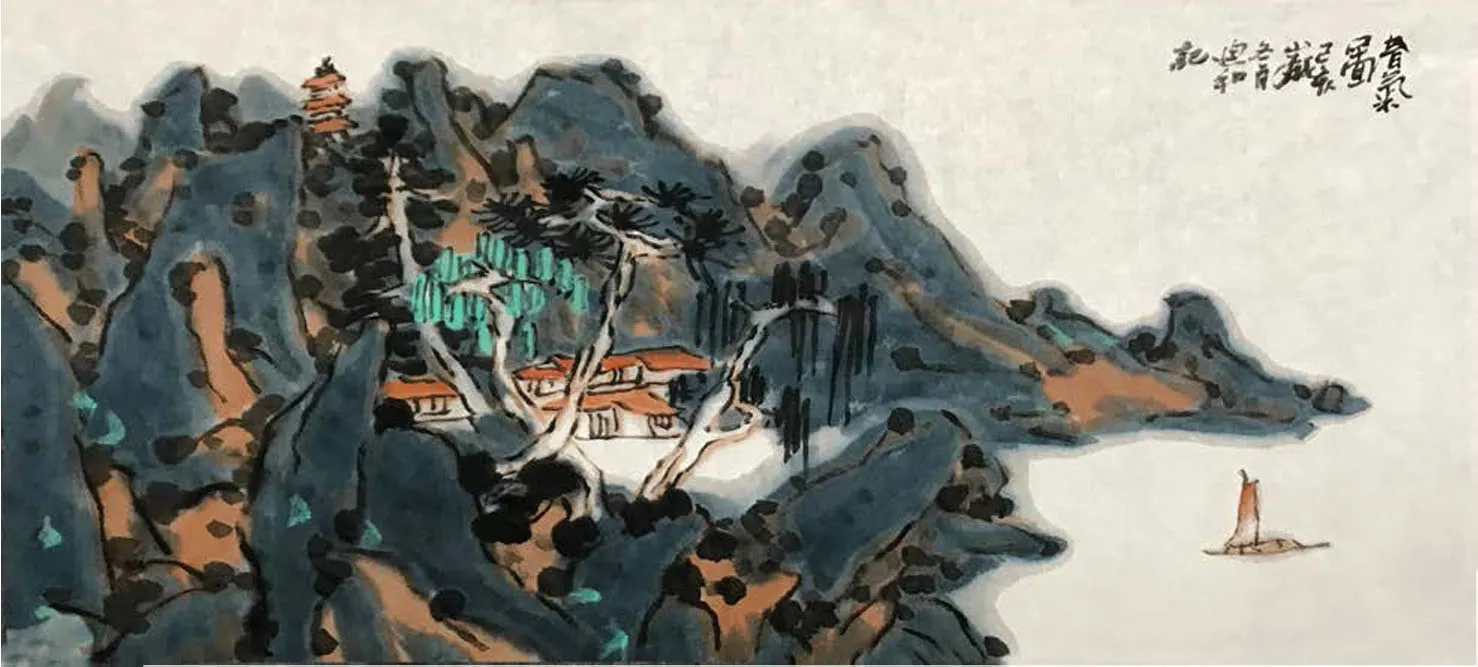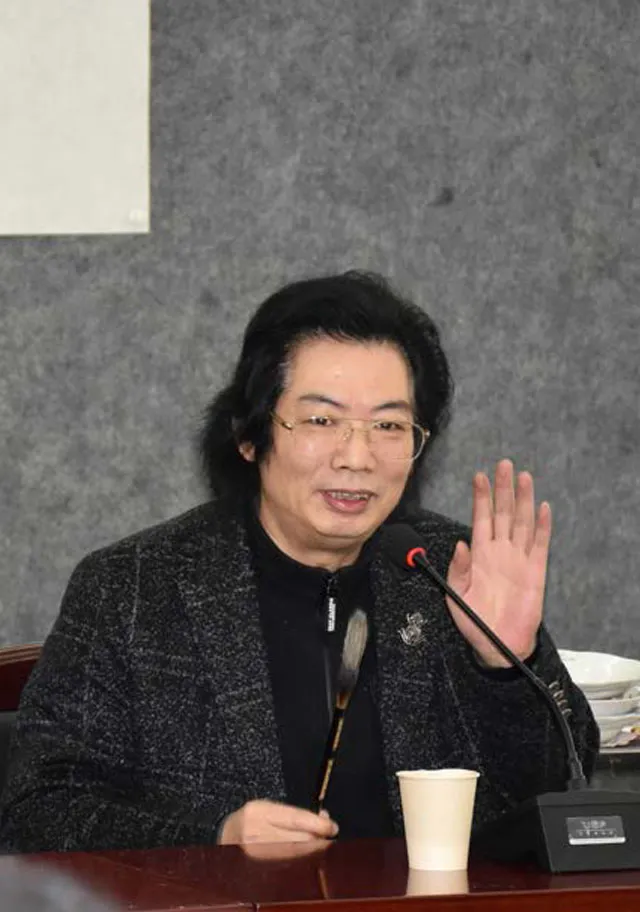A Vivid Lesson in Chinese Painting
By He Sai, Bo Ning & Zhang Yiqiu
Photos by Song Dezhi & Cai Jun

Painters from Hubei Academy of Chinese Painting and international students with their impromptu painting各国留学生在湖北省国画院合影留念

Chen Dihe, president of the academy, demonstrating for International students 国画院院长陈迪和向留学生示范如何绘制中国画
SFSecond Class Second Class is an extra-curricular cultural activity organized by the Special Focus Multilingual Publishing Center for international students in China.The main purpose is to integrate resources, cooperate with colleges of international education to enhance the understanding of Chinese culture through various cultural experiences, promote cultural exchanges, and help Hubei become known to the outside world.
What is Chinese painting like? What's special about Chinese painting?
On the afternoon of December 26, 2019, more than 20 students from over 10 countries attending Central China Normal University came to the Hubei Academy of Chinese Painting (HACP) with a long list of questions, looking forward to unveiling the mystery of Chinese painting.
This time, Special Focus had its “second class” activity at the art gallery on the second floor of the HACP, where the finished works of trainees who have learned Chinese painting were on display.Big scrolls of Chinese paintings glittered and shined in the brightly lit room.As painter Liu Xiaogang explained, the students moved slowly around the works and took photos with the paintings, marveling from time to time.
“Traditional Chinese painting falls into three categories according to its content: landscape painting, figure painting, and paintings of flowers and birds.If judged by the artistic genre, there is freehand brushwork and meticulous painting.” Surrounded by international students, Mr.Chen Dihe, president of the academy, delightedly introduced different styles of Chinese painting.Some works have soft lines and a unique style; some contain majestic mountains and amazing views.The varied images and styles have sparked heated discussions.“This composition is very interesting,” commented Retselisitsoe Khitsane from Lesotho.“My perspective here is like that of the gods, I can see mountains far away and a cityscape even further.”

New Spring, an impromptu painting by Mr.Chen Dihe陈迪和院长现场绘制作品《春气图》
SF第二课堂第二课堂是特别传媒多语种出版中心为在华留学生组织的课外文化实践活动。主旨是整合各方资源,联合高校国际教育学院,通过各种文化体验活动,增进留学生对中华文化的了解,促进文化交流和湖北对外开放。
中国画是什么样的?中国画有什么讲究?
12月26日下午,带着一串神秘的问题,来自十多个国家的二十余名华中师范大学留学生来到湖北省国画院,期待在这里一探究竟。
活动从国画院二楼的美术馆开始。这里正展出研修班学员半年学习成果,一幅幅巨幅中国画在明亮的灯光中,格外新颖夺目。留学生们随着画家刘小刚的讲解移步慢品,纷纷与画作合影留念,不时发出由衷的惊叹。
“传统国画按内容大致分为三种,山水画、花鸟画和人物画;按艺术风格来分,分写意画和工笔画。”被留学生包围着的陈迪和院长向大家介绍。画作有的线条柔美,风格文气;有的高山巍巍,凛然大气。多变的风格和画面引发了大家的热烈讨论。“这幅画的构图非常有趣,”来自莱索托的何山这样评价道,“我的视角就像神仙一样,能看到很远的山林和更远的城市高楼。”
大家被一幅主题为小女孩伏案学习的作品《四二班日志》吸引过去,它的画面构思精巧而有想象力:近处的香案上烟雾缭绕;远方层峦叠翠,崇山峻岭在云朵间时隐时现;天上幻化出仙境,能看到端坐的菩萨和低语的仙女。小女孩低着头,在山间专注地写字,柔和的氛围更添一丝静谧。大家仔细地观察画中的细节,纷纷上前拍照记录,感叹东方艺术的魅力。
为了让留学生们更多地了解中国画,画院专门安排了座谈会,由陈院长向大家详细讲解中国画特色:“中国画主要工具有五种:笔、墨、宣纸、水、颜色,蕴含着中国传统文化独特的哲学思想。”陈院长把国画和中国哲学结合起来,以此诠释各种绘画工具所深藏的哲理。
说起毛笔,“毛笔由一根笔杆和千百根兽毛组成,一硬一软、一多一少,寓变于不变,刚柔相济,阴阳相生。毛随杆动,笔法千变万化;一笔在手,描绘出大千万象来。”陈院长边说边向大家展示不同笔法及效果。
提及墨,他举着瓶子告诉大家,阳光由赤、橙、黄、绿、青、蓝、紫组成,如果把这七种颜色混和起来,就是黑色。所以,中国画的墨与水相和后,可以分为无数层级,具有无比丰富的表现力。
“一般的绘画是用眼睛观察某个物体,再用工具描绘。中国画不描绘具体物体,而是将景物内化于心,融入天道与人道两个方面的规律,再创作。天道即自然规律,人道是为人的规矩和社会规律。”
“中国画只能用黑色的颜料吗?”来自斯里兰卡的安吉娜用流利的中文问道。

International students taking photos of their favorite paintings留学生拍下喜爱的国画作品
The international students were attracted to the paintingLog of Class 2 Grade 4, in which a young girl is studying at her desk.The painting is delicate and imaginative: smoke from the incense burner on the altar table is vaguely fainting nearby; green mountains loom through the clouds far away.The sky is transformed into a fairyland where sitting bodhisattvas and whispering nymphs can be seen.The little girl lowers her head and writes intently somewhere in the mountains, which adds a sense of serenity to the soft atmosphere.The visiting students carefully observed the details in the painting, went forward for photos, and were moved by the charm of oriental art.
In the later symposium, Mr.Chen explained the characteristics of Chinese painting in details: “Five main tools are commonly used in Chinese painting, that is, brush, ink, xuan paper, water, and color.” Mr.Chen then combined traditional Chinese painting with Chinese philosophy to explain the hidden truth of the painting tools.
Speaking of the brush, “The brush is made up of a pen holder and hundreds of animal hairs.One end is hard and the other is soft.One is single and the other is plural.The hair moves with the holder, and the brushwork changes constantly.With one brush, I can paint everything.” He said while showing different brushwork and their effects.
Speaking of ink, he held up a bottle and told everyone that ink color, like sunlight, consists of red, orange, yellow, green, brown, blue, and purple—if you mix them up you will get black.Therefore, the mix of ink and water can yield countless layers with extremely rich expressiveness.
“When painting, it is quite normal to observe one object with your eyes and then paint it with some tools.However, Chinese paintings do not depict specific objects, instead, you need to internalize what you see in your heart, into the Dao of nature and the Dao of humanity, before you compose a picture.The Dao of nature means natural laws.The Dao of humanity covers the nature of humans and the laws of society.”
“国画色彩通常点到为止,它可以有很多颜色,但画家通常用得不多。我一般是用三种颜色,用得多的也不会超过四五种,有时候一种就够了。”陈院长解释道。
来自印度的孟妮紧接着问:“现代的中国画与传统的中国画是一样的吗?”
国画院专业画家胡智勇教授介绍说:“中国画是一脉相承的。无论哪个朝代,国画都是主流,只不过各个朝代的画有各个朝代的烙印。因为艺术是时代的文化,它总是在继承和创新中反映时代。”

Students trying Chinese painting 留学生纷纷提笔尝试绘中国画
来自孟加拉的易卜甚至问了一个十分尖锐的问题:“中国画这么出名,为什么现在很多人都去学西方的油画呢?”
陈院长说:“鸦片战争以来的100 多年,中国经历了一个特殊时期。西方油画也就是在这个时期进入中国,崇尚者不少,但这并不意味着中国画被冷落。相反,中国画同样备受世界艺术爱好者的喜爱,对中国画的收藏一直是一大热门。很多世界级的博物馆都收藏有中国历代名画。中国文化是包容的,中国艺术也是包容的。世界艺术是个大家庭,艺术爱好者自然有自己的审美取向。喜欢油画也好,喜欢中国画也好,江山代有人才出,层出不穷的艺术人才必将为中国的未来创造出一个色彩缤纷的艺术大家庭来。”
一番了解后,大家对亲手创作中国画跃跃欲试。留学生们纷纷操起毛笔,模仿着陈院长的笔法在宣纸上勾画起来,在场的中国画家老师们也耐心指点起留学生,时不时还亲自提笔示范。
白纸上的内容渐渐丰富起来,留学生们画出了角落里的小孩、肃穆的男人侧面像、枝头停歇的小鸟、山林里升起炊烟的小屋、别具情趣的涂鸦大杂烩……体现留学生对中国画元素的模仿,融合了他们各自的文化背景。
易卜是专业学习油画的,他即兴绘制了一枝绽放的梅花,得到了画家们的赞赏。这也正好说明,虽然技法有所不同,艺术的底色是相通的。
学生们兴奋地和画家们交流,一拨拨在画前合影留念,意犹未尽。许多学生表示,这是第一次进入专业殿堂进行绘画交流和亲身实践,如果有机会,希望能更深入地学习和了解中国画。
写意悠远的画作、详实独到的讲解、新奇有趣的尝试给大家留下了深刻的印象。今天,中国画以他的独特魅力收获来自世界各地的粉丝。
中国画的一个重要流派——荆楚画派,既有悠远的荆楚文化渊源,也有深厚的历史底蕴。以艺术作为连接东西方文化的桥梁,所有在场的留学生对于中国画这一中国优秀传统文化有了更深入的理解。

Mr.Chen Dihe illustrating the art of Chinese painting to the students陈迪和院长为留学生讲解国画艺术

Monika Sethuraman from India raising a question to the painters印度学生孟妮现场提问
“Do traditional Chinese paintings only adopt black color?” Asked J.A.Anjula Keshani, from Sri Lanka, in fluent Chinese.
“There is usually not much color in traditional Chinese painting.It could have many colors, but normally Chinese painters do not use that many.I usually use three colors, and no more than four or five.Sometimes one color is enough.” Mr.Chen explained.
Monika Sethuraman from India then asked, “Is modern Chinese painting the same as traditional Chinese painting?”
Professor Hu Zhiyong, a professional painter from the academy, answered: “The inner spirit of Chinese painting is the same.No matter in which dynasty, Chinese painting has been the dominating art genre, but the paintings of each dynasty have their own features.Art is the culture of the times, which always reflects the times in its inheritance and innovation.”
Ibrahim MD, from Bangladesh, even raised a quite surprising question: “Chinese painting is so famous, but why there are so many people learning Western oil painting now?”
“Over the past centuries since the Opium Wars, China has experienced a special historical period,” Chen said.“This is when Western oil painting entered China and attracted many admirers, but it does not mean that Chinese painting was ignored.On the contrary, Chinese painting is also admired by art lovers all around the world, and collections of Chinese paintings have always been a big hit in museums.Many worldclass museums have collections of famous Chinese paintings.Chinese culture is inclusive, and so is Chinese art.Global art is a big family, and art lovers naturally have their own aesthetic orientation and preference.Whether you like oil painting or Chinese painting, there are talented people from different generations and countries.This will surely create a colorful art family for the future of China.”
After the discussion, the students were all eager to try their hand at Chinese painting themselves.The international students took the brush, imitating Mr.Chen's brushwork and sketching on the xuan paper fixed on the wall.Some other Chinese painters in attendance also gave them some advice, and demonstrated proper techniques.The pieces of blank paper gradually became full and enriched by the attempts of the students.There were children, a solemn profile of a man, a few birds resting on branches, a cottage in the forest with a rising smoke, and some interesting calligraphy in their paintings.All these reflected their initial imitation of Chinese painting, with a blend of their own cultural backgrounds.
Ibrahim has majored in oil painting for years.He improvised a blooming plum blossom, which was much appreciated by the painters.It just showed that one form of art interlinks with others even with different methods.
The students were excited to talk with painters and took a group photo in front of the paintings.Many students said that this was the first time they had had the opportunity for hands-on Chinese painting practice.They hoped to learn Chinese painting more deeply another time.
They were impressed by the amazing works, detailed explanations, and interesting attempts.During this event, Chinese painting gained new fans in those international students.
Jingchu Painting School, an important school of Chinese painting, has long been associated with Hubei culture and has profound historical heritage in the region.With art as a bridge linking Eastern and Western cultures, all students present gained a deeper understanding of Chinese painting, an excellent symbol of traditional Chinese culture.

Students taking a selfie in front of the painting Log of Class 2 Grade 4留学生们在作品《四二班日志》前拍照留念

